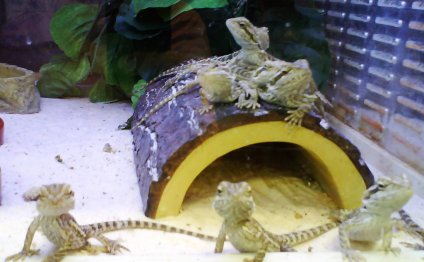
Pet Store lizards
10 to 20 years
AVERAGE SIZE:
18 - 20 inches
CAGE TEMPS:
Warm side - 85-90℉
Basking - 95℉
Cool side - 75℉
* If temp falls below 70℉ at night, may need supplemental infrared or ceramic heat for night-time
CAGE HUMIDITY:
Low(desert dweller)
WILD HISTORY:
Blue tongue skinks are from the open woodland and forest and field areas of Australia, Tasmania and New Guinea. There are quite a few species of blue tongue skink, and several kinds may be available in the pet trade.
PHYSICAL CHARACTERISTICS:
Blue tongue skinks have long, slim, smooth and chubby bodies. The scales are smooth. The legs are small and short, seemingly unsuitable for carrying the chunky body. The tongue is, of course, blue in color. It is thought that this unusual tongue is used to scare of would-be predators and to find food. They are generally a caramel-tan in color with black bands across the back.
NORMAL BEHAVIOR & INTERACTION:
Very social & engaging and generally very gregarious. Blue tongue skinks handle well and often seem to actually enjoy being held & petted. In nature, males become territorial and can engage in ritualized dominance struggles. Females may also have trouble getting along. For this reason, it is easiest for the pet owner to keep only one per enclosure.
Housing male skinks together will create a dominant/submissive hierarchy and will result in one skink becoming stressed to the point of illness, anorexia, and possibly death. Male skinks also tend to be extremely aggressive toward one another and will fight, sometimes to the death.
Female skinks may be housed together IF there is ample space and food for each skink.
Males and females should NOT be housed together, as the male skinks will continually try to mate with the females, leaving the females exhausted, aggravated, and stressed. The female may stop eating and become extremely ill.
NOTE: DO NOT house blue tongue skink with other species due to the differences in care, temperatures, and the fact that some species can be highly stressed in the presence of other species.
FEEDING:
Blue tongues are omnivorous, which means they eat both meat and vegetables. About 60% of an adult’s diet should be made up of plant matter, the remaining percentage being protein. Feed as much as your skink will eat, the majority being vegetation and fruit, they seldom over-eat.
VEGETABLES: Dark leafy vegetables such as collard and mustard greens, kale and red tip leaf lettuce are good for a dragon, as are alfalfa pellets, clover, parsley, and broccoli, green beans, peas, squash, grated carrots and sweet potatoes. Spinach and iceberg lettuce should never be fed. Remember to wash vegetables thoroughly, then cut or shred to make it easier to ingest. Remove any uneaten vegetables before turning the lights off at night.
FRUIT: Blue tongue skinks seem to love berries and fruit. Be sure to offer a good amount as often as possible. Fruits such as figs, kiwi, apples, raspberries, strawberries and melons can be fed.
PROTEIN: Protein sources such as: gut-loaded crickets, mealworms, cockroaches, kingworms, wax worms and pinkie mice dusted with a supplement should also be part of their diet. Wild caught insects should never be fed, since they can carry disease. All insects should be gut loaded (fed a nutritious diet about 24-hours before being offered to your skink - see our cricket care sheet). Be careful to feed the proper size prey for your skink’s size. A good rule of thumb is that a cricket should be never be larger than the distance between the lizard's eyes, or the distance from its eyes to its nose. When feeding larger insects to your pet, try to make sure the insects have recently molted, as an insect with a large, hard exoskeleton is difficult to digest and may cause impactions.
LIGHTNING BUGS MUST NEVER BE FED TO A BLUE TONGUE SKINK. THEY ARE POISONOUS.
All uneaten insects should be removed from the enclosure as they can bite your skink and cause injury, especially to the eyes. Some blue tongue skink owners find it easier to feed their pet in a separate enclosure, free of bedding and furniture, this way you can be sure your lizard eats all its insects, the prey cannot hide, and the lizard will not pick up any bedding when grabbing prey and mistakenly ingest it along with the prey. Commercially prepared skink diets are available, but they should never constitute the whole diet of your lizard. They can be left in the enclosure (on the cool side) in case your pet is hungry between meals.
RELATED VIDEO



Share this Post
Related posts
Colorful lizard
A very large species of chameleon that is endemic to forests in eastern and northern Madagascar. They reach up to 68 cm (27…
Read MorePet stores with snakes
15 - 20 years CAGE TEMPS: Warm side - 85 ℉ Cool side - 75 ℉ * If room temperature falls below 70 degrees at night, a supplemental…
Read More Blue tongue lizard redirects here. For the aboriginal Australian myth, see Bluetongue Lizard (mythology).
Blue tongue lizard redirects here. For the aboriginal Australian myth, see Bluetongue Lizard (mythology).











